The first place to visit is the temple Sairen-ji, located southwest of the city. Head west along Highway 163, cross over the Shin-nagata Bridge, spanning across the Kizu River, and arrive upon a bucolic field. |
| 1. Sairen-ji Temple |
 Walk up a stone path, surrounded by verdant trees, through the temple gate, and arrive upon the main hall. This temple was established by the Tendai master Saichô (767-822) and formerly called Kannon-ji. During the Meiô era (1492-1501), the founder of the Shinzei branch of the Tendai sect, Shinzei (1443-95), held a Nembutsu gathering and renamed the temple Sairen-ji. The temple prospered under the patronage of the emperors Gotsuchimikado (1442-1500) and Gokashiwabara (1464-1526), who were deeply devoted to Shinzei. However, many of the buildings collapsed during an earthquake, and the present halls were reconstructed at the beginning of the Meiji period (1868-1912). In the cemetery behind the main hall lie the graves of Shinzei and Emperor Gotsuchimikado, and a five-story memorial pagoda for the emperor's second son, the Imperial Prince Sonsei.
Walk up a stone path, surrounded by verdant trees, through the temple gate, and arrive upon the main hall. This temple was established by the Tendai master Saichô (767-822) and formerly called Kannon-ji. During the Meiô era (1492-1501), the founder of the Shinzei branch of the Tendai sect, Shinzei (1443-95), held a Nembutsu gathering and renamed the temple Sairen-ji. The temple prospered under the patronage of the emperors Gotsuchimikado (1442-1500) and Gokashiwabara (1464-1526), who were deeply devoted to Shinzei. However, many of the buildings collapsed during an earthquake, and the present halls were reconstructed at the beginning of the Meiji period (1868-1912). In the cemetery behind the main hall lie the graves of Shinzei and Emperor Gotsuchimikado, and a five-story memorial pagoda for the emperor's second son, the Imperial Prince Sonsei. |
Sairen-ji Temple
Nagata, Ueno City, Mie Prefecture
Tel. 0595-21-4111 (Ueno Visitors' Office) or 0595-24-0270 (Ueno Visitors' Information).
From Kintetsu Iga Line, get off at Ueno City Station, take the bus headed for Shimagahara and get off at the Nagata stop. Walk 10 minutes from the Nagata bus stop.
|
|
Go west along Highway 163 through a lush green bamboo grove. From the village of Shimagahara, head north towards the train station along the bank of the Kizu River to Shôgatsu-dô. |
| 2. Kanbodai-ji Temple (Shôgatsu-dô) |
 This historical temple formerly served as the grounds for the detached palace of Emperor Shômu (701-756) during the Tenpyô era (729-749). Later, the priest Jitchû restored the buildings and laid the foundations for his temple. Receiving the patronage of successive emperors, the temple prospered, however, during the Tenshô era (1573-92), the grounds were burned down in the ravages of war. The present temple was later rebuilt, while the main hall, tower gate, and central image of devotion that escaped the fire have been designated Important Cultural Properties. Especially notable is the Eleven-Headed Kannon, the central image, which is a hidden image that is only shown once in thirty-three years, the next opening being 2015.
This historical temple formerly served as the grounds for the detached palace of Emperor Shômu (701-756) during the Tenpyô era (729-749). Later, the priest Jitchû restored the buildings and laid the foundations for his temple. Receiving the patronage of successive emperors, the temple prospered, however, during the Tenshô era (1573-92), the grounds were burned down in the ravages of war. The present temple was later rebuilt, while the main hall, tower gate, and central image of devotion that escaped the fire have been designated Important Cultural Properties. Especially notable is the Eleven-Headed Kannon, the central image, which is a hidden image that is only shown once in thirty-three years, the next opening being 2015. |
Kanbodai-ji Temple
Nakamura, Shimagahara-mura, Ayama-gun, Mie Prefecture.
Tel. 0595-59-3080. Entrance fee: ¥300 (reservation required).
From JR Station Shimagahara Station, take the Mie Bus to Shôgatsu-dô Higashi.
|
|
| After crossing the prefectural border from Mie to Kyoto, you will arrive upon the only village in Kyoto Prefecture, Minamiyamashiro Village. Turn right at the traffic light before the town office, then keep an eye out for the sign “Herabuna” to turn left into the alley to arrive upon... |
| 3. Shunkô-ji Temple |
 The central image of Muryô Shunkô-ji, a temple of the Chinzan branch of the Shingon sect, is a standing Yakushi (Medicine Buddha), made of a single block of kaya, Japanese nutmeg, in the early Heian period (794-1192). This statue, designated an Important Cultural Property, suggests the strong cultural and stylistic influences that this area once received from the ancient capital Nara and its environs. This Yakushi is among the few examples of wooden Buddhist sculptures carved from a single block with such lustrous cheeks and rounded body.
The central image of Muryô Shunkô-ji, a temple of the Chinzan branch of the Shingon sect, is a standing Yakushi (Medicine Buddha), made of a single block of kaya, Japanese nutmeg, in the early Heian period (794-1192). This statue, designated an Important Cultural Property, suggests the strong cultural and stylistic influences that this area once received from the ancient capital Nara and its environs. This Yakushi is among the few examples of wooden Buddhist sculptures carved from a single block with such lustrous cheeks and rounded body. |
Shunkô-ji Temple
Minamiyamashiro-mura, Sôraku-gun, Kyoto Prefecture.
Tel. 0743-93-0101 (Minamiyamashiro Town Office).
A 20-minute walk from JR Ôkawara Station.
|
|
Drive along Highway 163, as if tracing the Kizu River, from Minamiyamashiro Village to Kamo-chô. Enjoy the drive with lush trees to the right and a gently meandering river to the left. From around the area of the short-lived, former capital, Kuninokyô, head on Route 44 towards Kamo, a town rich with history and culture, eternally carved into time. |
| 4. Genkô-ji Temple |
 Neither the origin nor history of this small temple, in midst of a bamboo grove, is known. However, during the Edo period (1600-1868), it greatly prospered and records show that grand services were held here. The central image of worship is an unusual seated Eleven-Headed Kannon, designated an Important Cultural Property. Apparently, the precepts were strictly upheld at this temple, where a stone pillar prohibiting alcohol still stands next to the main hall.
Neither the origin nor history of this small temple, in midst of a bamboo grove, is known. However, during the Edo period (1600-1868), it greatly prospered and records show that grand services were held here. The central image of worship is an unusual seated Eleven-Headed Kannon, designated an Important Cultural Property. Apparently, the precepts were strictly upheld at this temple, where a stone pillar prohibiting alcohol still stands next to the main hall. |
Genkô-ji
Kita Yamanoue, Kamo-chô, Sôraku-gun, Kyoto Prefecture.
Tel. 0774-76-3611 (Kamo Town Office).
A 20-minute walk from JR Kamo Station.
|
|
| 5. Jônen-ji Temple |
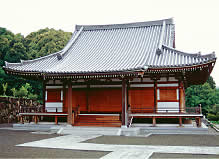 This temple was built in 1490 by Seikei, a disciple of the Tendai master Shinzei (1443-95). In the past, it was counted as one of ten major branch temples, though later it declined. In 1712, the buildings were swept away in a flood and rebuilt in their present location. The temple has many treasures, including its central image, a standing Amida Buddha, the Ten Enma Kings by Chinkei (act. ca. 1474-76), and a painting of the Buddha's Passing.
This temple was built in 1490 by Seikei, a disciple of the Tendai master Shinzei (1443-95). In the past, it was counted as one of ten major branch temples, though later it declined. In 1712, the buildings were swept away in a flood and rebuilt in their present location. The temple has many treasures, including its central image, a standing Amida Buddha, the Ten Enma Kings by Chinkei (act. ca. 1474-76), and a painting of the Buddha's Passing. |
Jônen-ji Temple
Kamo-chô Sato, Kamo-chô, Sôraku-gun, Kyoto Prefecture.
Tel. 0774-76-2970 (Kamo-chô Visitors Bureau), 0774-76-3611 (Kamo Town Office).
A 10-minute walk from JR Kamo Station.
|
|
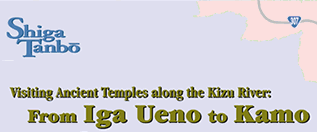
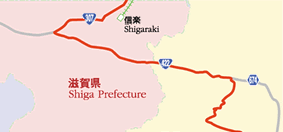
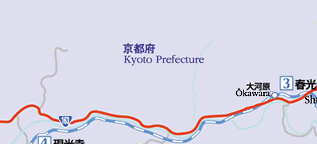
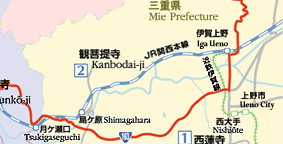










 Walk up a stone path, surrounded by verdant trees, through the temple gate, and arrive upon the main hall. This temple was established by the Tendai master Saichô (767-822) and formerly called Kannon-ji. During the Meiô era (1492-1501), the founder of the Shinzei branch of the Tendai sect, Shinzei (1443-95), held a Nembutsu gathering and renamed the temple Sairen-ji. The temple prospered under the patronage of the emperors Gotsuchimikado (1442-1500) and Gokashiwabara (1464-1526), who were deeply devoted to Shinzei. However, many of the buildings collapsed during an earthquake, and the present halls were reconstructed at the beginning of the Meiji period (1868-1912). In the cemetery behind the main hall lie the graves of Shinzei and Emperor Gotsuchimikado, and a five-story memorial pagoda for the emperor's second son, the Imperial Prince Sonsei.
Walk up a stone path, surrounded by verdant trees, through the temple gate, and arrive upon the main hall. This temple was established by the Tendai master Saichô (767-822) and formerly called Kannon-ji. During the Meiô era (1492-1501), the founder of the Shinzei branch of the Tendai sect, Shinzei (1443-95), held a Nembutsu gathering and renamed the temple Sairen-ji. The temple prospered under the patronage of the emperors Gotsuchimikado (1442-1500) and Gokashiwabara (1464-1526), who were deeply devoted to Shinzei. However, many of the buildings collapsed during an earthquake, and the present halls were reconstructed at the beginning of the Meiji period (1868-1912). In the cemetery behind the main hall lie the graves of Shinzei and Emperor Gotsuchimikado, and a five-story memorial pagoda for the emperor's second son, the Imperial Prince Sonsei. This historical temple formerly served as the grounds for the detached palace of Emperor Shômu (701-756) during the Tenpyô era (729-749). Later, the priest Jitchû restored the buildings and laid the foundations for his temple. Receiving the patronage of successive emperors, the temple prospered, however, during the Tenshô era (1573-92), the grounds were burned down in the ravages of war. The present temple was later rebuilt, while the main hall, tower gate, and central image of devotion that escaped the fire have been designated Important Cultural Properties. Especially notable is the Eleven-Headed Kannon, the central image, which is a hidden image that is only shown once in thirty-three years, the next opening being 2015.
This historical temple formerly served as the grounds for the detached palace of Emperor Shômu (701-756) during the Tenpyô era (729-749). Later, the priest Jitchû restored the buildings and laid the foundations for his temple. Receiving the patronage of successive emperors, the temple prospered, however, during the Tenshô era (1573-92), the grounds were burned down in the ravages of war. The present temple was later rebuilt, while the main hall, tower gate, and central image of devotion that escaped the fire have been designated Important Cultural Properties. Especially notable is the Eleven-Headed Kannon, the central image, which is a hidden image that is only shown once in thirty-three years, the next opening being 2015. The central image of Muryô Shunkô-ji, a temple of the Chinzan branch of the Shingon sect, is a standing Yakushi (Medicine Buddha), made of a single block of kaya, Japanese nutmeg, in the early Heian period (794-1192). This statue, designated an Important Cultural Property, suggests the strong cultural and stylistic influences that this area once received from the ancient capital Nara and its environs. This Yakushi is among the few examples of wooden Buddhist sculptures carved from a single block with such lustrous cheeks and rounded body.
The central image of Muryô Shunkô-ji, a temple of the Chinzan branch of the Shingon sect, is a standing Yakushi (Medicine Buddha), made of a single block of kaya, Japanese nutmeg, in the early Heian period (794-1192). This statue, designated an Important Cultural Property, suggests the strong cultural and stylistic influences that this area once received from the ancient capital Nara and its environs. This Yakushi is among the few examples of wooden Buddhist sculptures carved from a single block with such lustrous cheeks and rounded body. Neither the origin nor history of this small temple, in midst of a bamboo grove, is known. However, during the Edo period (1600-1868), it greatly prospered and records show that grand services were held here. The central image of worship is an unusual seated Eleven-Headed Kannon, designated an Important Cultural Property. Apparently, the precepts were strictly upheld at this temple, where a stone pillar prohibiting alcohol still stands next to the main hall.
Neither the origin nor history of this small temple, in midst of a bamboo grove, is known. However, during the Edo period (1600-1868), it greatly prospered and records show that grand services were held here. The central image of worship is an unusual seated Eleven-Headed Kannon, designated an Important Cultural Property. Apparently, the precepts were strictly upheld at this temple, where a stone pillar prohibiting alcohol still stands next to the main hall. This temple was built in 1490 by Seikei, a disciple of the Tendai master Shinzei (1443-95). In the past, it was counted as one of ten major branch temples, though later it declined. In 1712, the buildings were swept away in a flood and rebuilt in their present location. The temple has many treasures, including its central image, a standing Amida Buddha, the Ten Enma Kings by Chinkei (act. ca. 1474-76), and a painting of the Buddha's Passing.
This temple was built in 1490 by Seikei, a disciple of the Tendai master Shinzei (1443-95). In the past, it was counted as one of ten major branch temples, though later it declined. In 1712, the buildings were swept away in a flood and rebuilt in their present location. The temple has many treasures, including its central image, a standing Amida Buddha, the Ten Enma Kings by Chinkei (act. ca. 1474-76), and a painting of the Buddha's Passing.